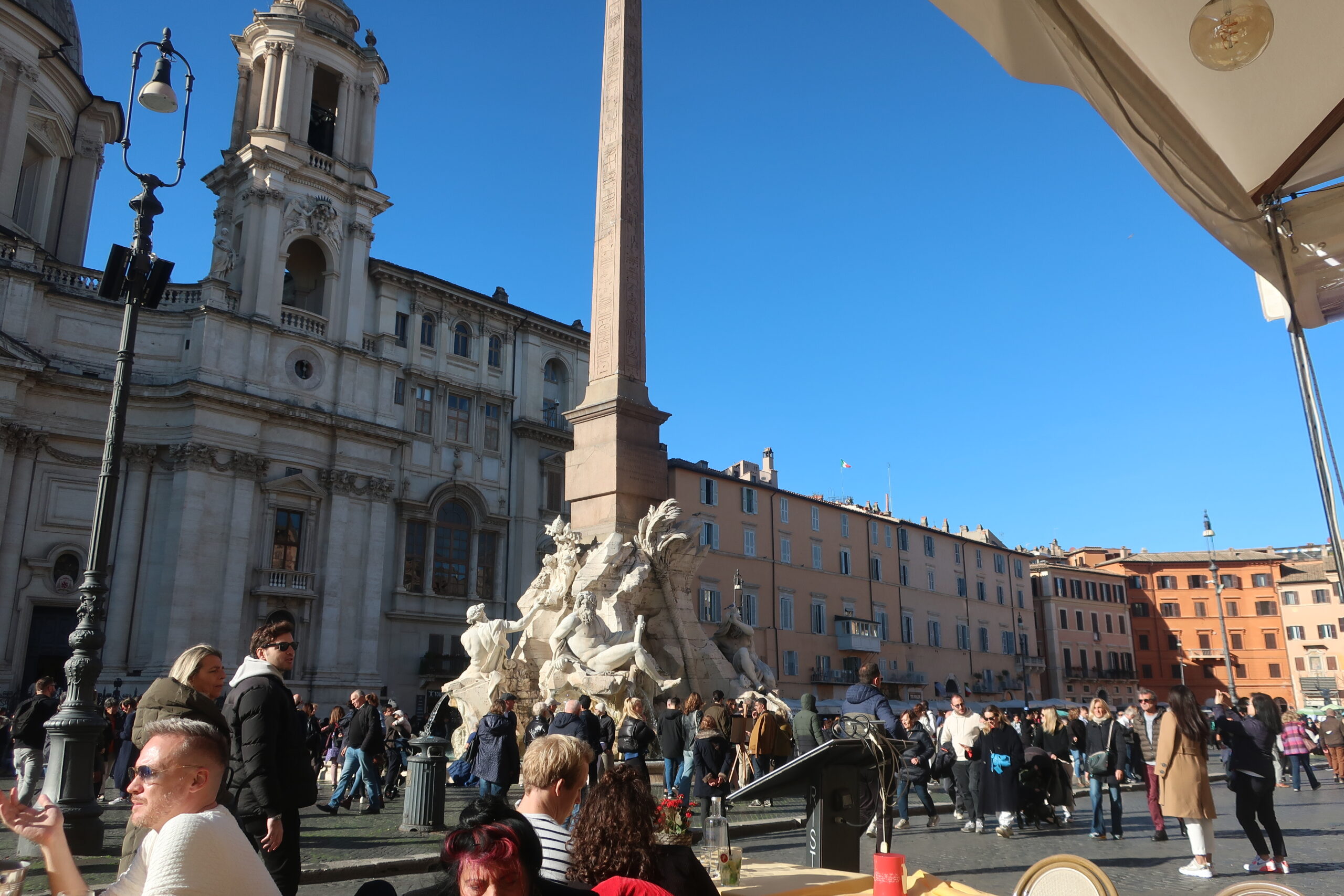Table of Contents
- 1 (28) "Fountain of the Four Rivers" in Piazza Navona, Rome - Bernini's complete revival from the fall from grace! A masterpiece that even the Pope, who had been his adversary, praised!
- 1.1 Bernini's dramatic return to the front line!
- 1.2 Fountain of the Four Rivers" in Piazza Navona
- 1.3 Another of Bernini's talents - his personality as a courtesan and his ability as a propagandist to perfectly meet the expectations of his clients.
- 1.4 Director Bernini's stylish plan - an act that delighted Pope Innocent X.
- 1.5 While the highly acclaimed "Fountain of the Four Rivers" was...
(28) "Fountain of the Four Rivers" in Piazza Navona, Rome - Bernini's complete revival from the fall from grace! A masterpiece that even the Pope, who had been his adversary, praised!
Previous Article(27) Bernini's "The Ecstasy of Saint Teresa" - A masterpiece of Baroque art! The marvelous illusions of the Cornaro Chapel!"In the following section, we introduced the Cornaro Chapel's "The Laws of Saint Teresa," which was born during Bernini's unfavorable period.
This article will introduce the "Fountain of the Four Rivers" in the Piazza Navona, which led to the complete revival of the ill-fated Bernini.
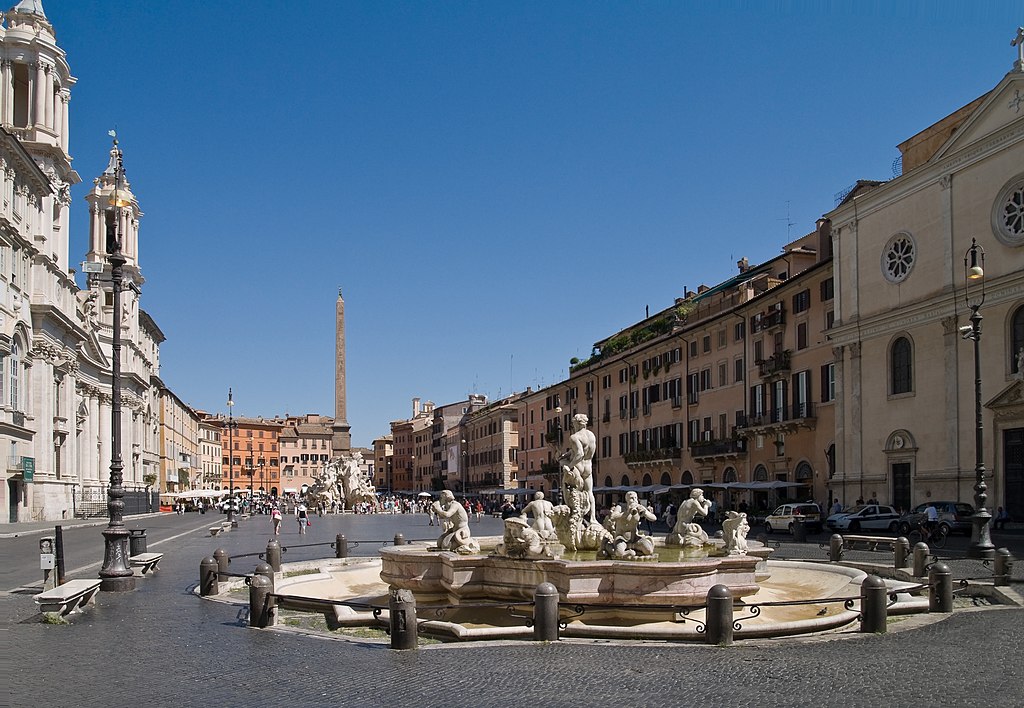
Bernini's dramatic return to the front line!
Around the time of the work on the Cornaro Chapel, Bernini hurried to complete the tomb of Urbanus VIII, who had died a year earlier. When it was completed and unveiled on March 1, 1647, Innocent X is said to have said, "They speak ill of Bernini, but he was a great and rare man. It would have been difficult for a Baroque monarch not to have used a talent like Bernini's for a long time. In fact, Innocent X would bring him back to the forefront in less than four years, but the circumstances of his return are, as always, somewhat theatrical.
The Piazza Navona, which retains exactly the remains of the Domitian's amphitheater, had been the center of Roman civic life since the market was moved from the Capitolino Hill in the late 15th century. As already mentioned, the Pamphili family's palazzo faced this square, and the Pope wanted to renovate it and build his own church there at the same time, turning it into "Pamphili's Island. Girolamo Rainaldi was hired to build the palazzo and the church of San Tannese, but he was an old man in his mid-seventies and was soon replaced by Boㇽromini, who supervised the construction. In addition to these works, the construction of a fountain was planned to decorate the square.
Two fountains had already been built at both ends of the square during the reign of Gregory XIII, and now the plan was to build a larger fountain in the center. However, in order to put this plan into action, a large amount of water was first needed, which had to be drawn from the Trevi Fountain. This task should have been entrusted to Bernini, who held the titles of "Superintendent of Waterworks and Fountains of Piazza Navona" and "Architect of Acqua Verginae. However, here, too, Bollomini was appointed in place of Bellini, who completed the work over a period of three years, starting in 1644.
Meanwhile, it had long been known that a fragment of the obelisk was located at the site of the amphitheater of Emperor Maxentius on the Old Appian Way. A competition was held to determine the plan for the fountain's decoration, and once again, Boccolomini's idea was chosen. Again, Bollomini's plan was chosen. Bernini was not even invited to participate in the competition.
But Bernini also had allies. According to the biographer, his old friend Niccolò Ludovisi, head of the Ludovisi family and son-in-law of Olympia, vizier of the Pamphili family, encouraged him to make a model of the fountain, and he did so (according to one source, Bernini made an elaborate silver model to attract Olympia's attention). (According to one source, Bernini made an elaborate silver model to attract Olympia's attention.) Olympia liked the model so much that Niccolò Ludovisi placed it in the room where the Pope passed after his meals. On the Feast of the Assumption of the Virgin (August 15)festival processionAfter finishing the "Pope's" work, he stopped for a meal, found the model, gazed at it for half an hour, and said, "I can think of no one better than Bernini for this design, and it must have been the work of Principe Ludovisi. And this must be the design of Principe Ludovisi. Some people may not want to use it, but we must use Bernini. He said, "Some people don't want this to happen, but we must use Bernini, because anyone who wants to avoid using his plan must not see it. He sent for Bernini that same day, expressed his regret at the way he had been treated, and ordered him to create the fountain. Thus, Boho Lomini suffered again, and Bernini finally returned to the forefront of the art world.
Masumi Ishinabe, Yoshikawa KobunkanBernini, Giant Star of Baroque Art.p114-116
*some line breaks.
Bernini's theatrical talent and the fact that he was a playwright, director, and actor.(24) Bernini's Raimondi Chapel - A spectacle of stunning light! Bernini as playwright and director."I also talked about this in my article on
It is often said that reality is stranger than fiction, and this is exactly how Bernini made his dramatic comeback.
Fountain of the Four Rivers" in Piazza Navona
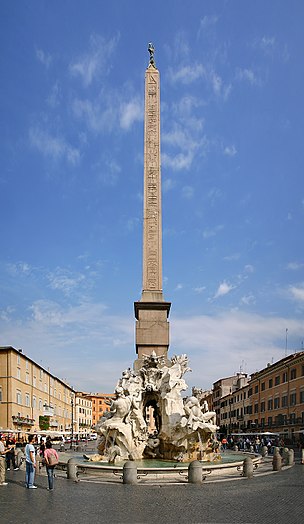
The Fountain of the Four Rivers, which Bernini created for Piazza Navona, consists of two ideas. The first was the idea of turning the pedestal of the obelisk into a hollow rock, and the second was to decorate it with allegorical images of the four major rivers.ideaThe obelisk found at the site of the amphitheater of Maxentius was divided into six pieces. The obelisk found at the site of the amphitheater of Emperor Maxentius was divided into six pieces, which had to be restored by connecting them, but it was not as difficult to erect as other obelisks. Even so, the great work involved in the creation of this fountain can be imagined from the fact that a source from the time tells us, "The great difficulty and hardship of the work can only be understood by those who saw it in action.
Strangely enough, however, we rarely experience such difficulties when confronted with this fountain in real life. We would rather think that Bernini did this with ease. This is due to the fact that the weight of the obelisk is almost imperceptible, even though it is in fact very heavy. This is the result of Bernini's ingenious idea of introducing a natural rocky hill into the geometrical and inorganic base of the obelisk, and then leaving the inside of the rocky hill hollow. It is a wonderful "magician's" work.stage settingIt can be said to be "a good thing.
Masumi Ishinabe, Yoshikawa KobunkanBernini, Giant Star of Baroque Art.p116-117
*some line breaks.
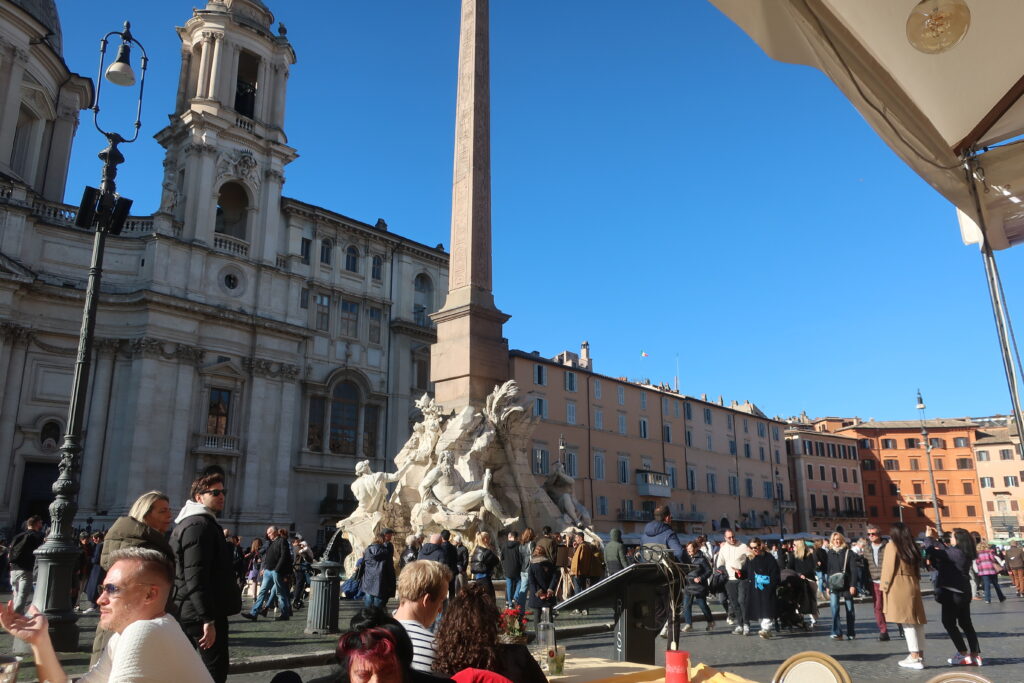
Indeed, as this commentary states, a quick glance does not convey the difficulty of the production. Perhaps it was the genius director Bernini's skill to make it look as if he had done it with ease.
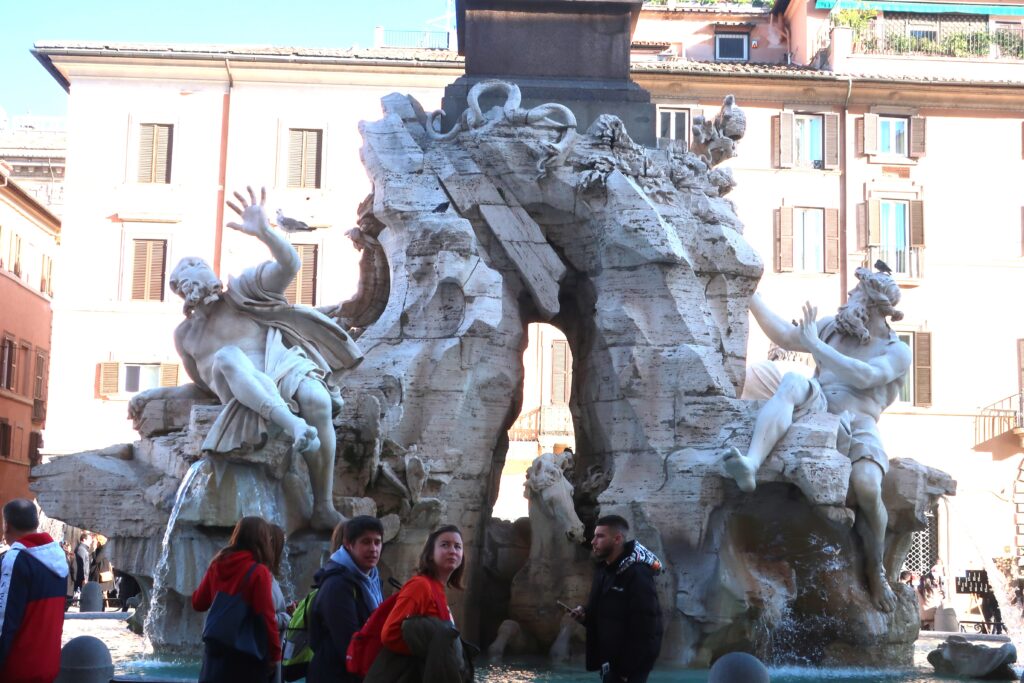
The carved section that serves as the base of the obelisk. You can clearly see that the rock is hollow.
Let's continue to look at the explanations.
In contrast, the idea of using allegorical images of the four major rivers to decorate the fountain is said to have already been considered by Boharomini. However, a single surviving drawing by Borromini indicates that his actual plan was quite simple: a simple bas-relief decoration on an obelisk pedestal, with water flowing out of the outlet.
In the first place, this kind ofstage-likeNo one can compete with Bellini in a work that requires a keen sense of the senses. Bernini began by transforming the base of the obelisk into a rocky mountain, and at the four corners of the fountain he created allegorical images of the four great rivers, symbolizing the four continents, with a dynamic physicality reminiscent of Michelangelo's. The Danube looks up at the obelisk, the Nile covers its eyes to show the mystery of its source, and the Ganges looks down at the water. The Danube looks up at the obelisk, the Nile covers its eyes to show that its source is mysterious, the Ganges has an oar to represent the abundance of water, and the Mallorcan La Plata shows its wealth of gold and silver by scattering coins along its sides. In addition to these main characters, Bernini added plants, such as the Shro (Nile) and cactus (La Plata), and animals representing the four major rivers: the horse (Danube), lion (Nile), snake (Ganges), and armadillo (La Plata). The horse iscaveThe lion crouches down to drink water, the snake scraps rocks, and the armadillo peeks out from behind a rock to entertain the viewer.
Bernini further varied the play by making the water spurt out from between the rocks. The resulting fountain is a living organism, an exquisite fusion of nature and fantasy. In this sense, this fountain is one of the mostpicturesqueIt is a work of art made of wood, paper and stucco, rather than a sculptural work.festivals(at sentence-end, falling tone) indicates a confident conclusionornamental deviceThe festive decorations were for a limited time only. Festive decorations, while temporary, provided a unique opportunity for artists to experiment, as they allowed for a freer expression of fantasy than sculpture. Bernini's "Fountain of the Four Rivers" is the result of such experimentation, and it is a reminder of the lostcityIt is the best relic of Rome.
Masumi Ishinabe, Yoshikawa KobunkanBernini, Giant Star of Baroque Art.p118-119
*some line breaks.
In the first place.stage-likeNo one can compete with Bernini when it comes to work that requires a strong sensory perception."
Oh! Bernini! Indeed, the overwhelming sense of fantasy and entertainment of this fountain makes me nod my head in agreement with these words.
Another of Bernini's talents - his personality as a courtesan and his ability as a propagandist to perfectly meet the expectations of his clients.
There is one more thing in the plan of this fountain that BoㇽRomini could not compete with Bernini: the "fountain" is a "fountain" that captures the hearts of the powerful and religious in the 17th century. It is a "fountain" that captures the hearts and minds of the powerful and religious people of the 17th century.ideaIn this respect, Bernini is unrivaled. In this respect, there is no equal to Bernini.
As Haskell points out, the Baroque concept of art as a tool of propaganda was established by Urbanus VIII and Bernini. In this sense, Bernini was an excellentcourtierSo Innocentius X, who at first treated him coldly, opened his heart to him. It is said that even Innocent X, who at first treated him coldly, opened his heart to him and always said, "Knight Bernini is a man born to mingle with the great princes. For a man with such courtly sensibilities, it should have been obvious what the Pope and the Pamphili family were looking for.
The film captures them in Bernini's "ideaThe "dove" was a dove with an olive branch atop an obelisk in honor of the Church and the Pamphili family, which reigns over the four rivers, or four continents. As is well known, the dove is a symbol of the Holy Spirit'ssymbolBut it was also the emblem of the Pamphili family. Since Sixtus V, obelisks have often been used to decorate squares, but at that time they always had a cross on them, representing the victory of the church over paganism. Bernini broke with this tradition.
Masumi Ishinabe, Yoshikawa KobunkanBernini, Giant Star of Baroque Art.p119
*some line breaks.
The talent to create something that exceeds the client's expectations. The ability to sense what the client is potentially looking for. Bernini even possessed this ability. Unlike the nervous and solitary Borromini, Bernini's sociable and witty personality must have had a lot to do with this. I think this is also an interesting episode to know about Bernini.
Director Bernini's stylish plan - an act that delighted Pope Innocent X.
And in this "Fountain of the Four Rivers," there is an episode that I would like to introduce.
It is a very stylish production, as is typical of Bernini, who is a theater man.
The fountain was completed about three years after construction began, but almost all of the actual work, including the four allegorical figures, was done by his pupils. According to Baldinucci, however, the horse, the lion, and the palm tree were created by Bellini himself. Although there is no documentation to support this, they are certainly lively works.
The biographer also relates the following episode concerning this fountain. Shortly before the fountain was unveiled on June 14, 1651, the Pope came to see it with about 50 people in attendance. The Pope enjoyed watching the fountain for about half an hour, but he still felt unsatisfied because there was no water, so he asked Bernini when water would be available. He asked Bernini when the water would come out, to which Bernini replied that he would try to do it as soon as possible. The Pope gave his blessing and left, but before he had proceeded even a single building, he heard the sound of water. Bernini signaled for the sluice to be opened. The group turned around and what they saw was "a spectacle that enchanted everyone. The Pope was so delighted that he clapped his hands and said, "This unexpected joy has prolonged my life by 10 years," and immediately sent an envoy to Olympia to fetch 100 doble, which he gave to the lowly craftsmen who worked on the fountain.playThis is an episode that is a true testament to Bernini's attempt to remove the boundary between art and reality in the 17th century, a time of spectacle and spectacle!
Masumi Ishinabe, Yoshikawa KobunkanBernini, Giant Star of Baroque Art.p120
*some line breaks.
I love this episode. It seems to convey Bernini's love of making people happy. I love the mischievousness of this performance, which is typical of a theater artist. By inserting this kind of light-hearted humor, rather than being solely serious, Bernini must have expanded his circle of interactions with various people. I can imagine how pleased the Pope was. Even the Pope, who used to be an enemy of Bernini, became completely absorbed in Bernini. It is a truly wonderful episode.
While the highly acclaimed "Fountain of the Four Rivers" was...
Although the fountain was highly praised by the Pope and admired by the citizens of Rome, it also caused mixed feelings among them. This is also a very important point when considering the Rome of Bernini's life.
The "Fountain of the Four Rivers" was highly acclaimed and quickly became one of Rome's most famous landmarks. Francesco Albizzi told Fabio Pisi (later Alexander VII), who was then in Arhén, "It is a miracle of the world. ......Bernini created two works to be remembered, one religious and the other secular. The former is the "St. Peter'sTomb of the SaintsThe fountain is the pillar that supports the Baldacchino, the work of the secular world, which surpasses even the most beautiful buildings of antiquity. It surpasses even the most beautiful structures of antiquity. It is hard to believe today, but within a year or so, eight books in praise of this fountain were published in succession. (omitted).
But the citizens of Rome who gathered in Piazza Navona to admire the fountain must have looked at it with both admiration and envy, because the pope imposed a new tax for its construction. The pope had imposed a new tax for the construction of the fountain, and the people lamented the fact that the fountain had been built in such a way that the pope had to pay for it. The price of wheat is going up day by day. The price of wheat is rising day by day. ......" Ziㇽli writes, "We are told that the piece of obelisk brought to Piazza Navona had the following epitaph affixed to it: 'We do not want the obelisk, we want the obelisk. We do not want the obelisk. We want bread. We want bread, bread, bread. As can be inferred from this, the social and economic situation in Rome was worsening due to a combination of factors.
Masumi Ishinabe, Yoshikawa KobunkanBernini, Giant Star of Baroque Art.p120-121
While the arts were flourishing, Rome was slowly declining...
By 1650, France had already become a major power, and the influence of Rome on Germany as a whole was clearly declining due to the Reformation. England and the Netherlands also begin to take their own course as maritime states. The Ottoman Empire is also a major threat.
In this world situation, Rome fell from its position as the center of Europe. At the end of its prosperity, Bernini appeared.
In fact, by the end of Bernini's life, Rome was even poorer, and Bernini's art was criticized as too expensive and he lost his position.
Rome is also interesting to look at while considering the political situation of Rome. The rise and fall of the Roman Empire is one thing, but the drama of the rise and fall of the Vatican is another.
be unbroken
*The following photos are my Bernini notes. I hope you will find them useful.
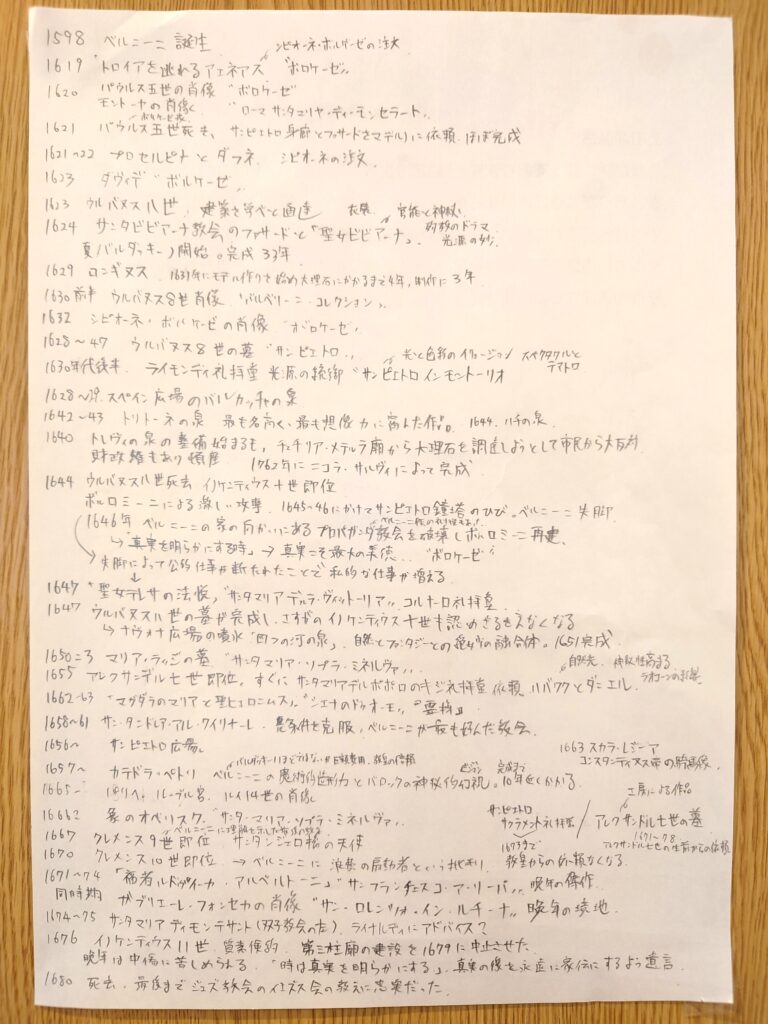
*The list of articles in the "Rome Travel Journal" can be found atCategory page hereindicates direction or goal (e.g. "to")
*Please visit this category page for recommended books to learn about Rome and Italy.
The Rise and Fall of the Roman Empire, the Vatican, and Roman Catholicism."
The Italian Renaissance and the Revolution in Knowledge."
Next Article.
Click here to read the previous article.
Related Articles











